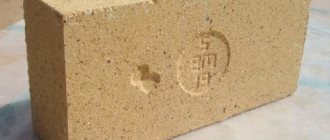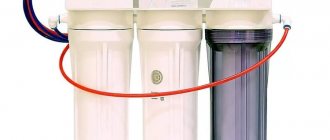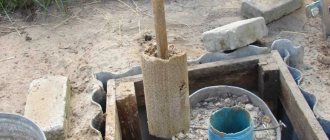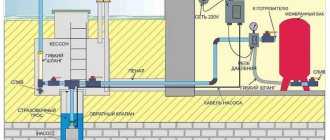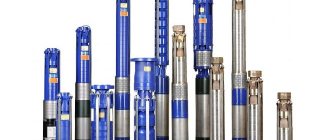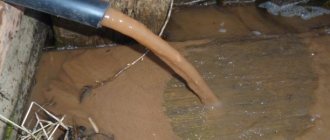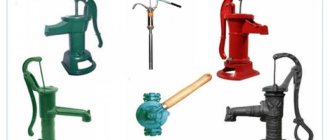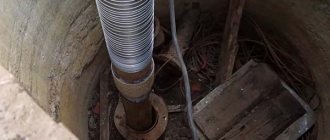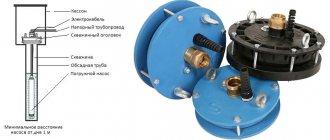Water is needed on a personal plot. Many resort to drilling a well. But the water in it is not always of high quality, and the construction process for the source is quite labor-intensive.
Over time, the level of water quality may deteriorate, so cleaning the source or deepening it may be useful.
Reasons for the disappearance of water
In fact, there could be many reasons for this. Among them:
- natural depletion of the source;
- natural disasters;
- violation of drilling technology, which leads to similar problems;
- severe clogging of the filter zone.
First, you need to understand that any source has a limited service life. For example, for artesian, it can reach 50 years. But a sand well can only operate for 10 years. Therefore, when the time comes, it simply dries up.
Another point is climatic and natural conditions. For example, during a severe drought, the aquifer may drain. The first thing to do is to check the nearest wells located nearby and fed from the same aquifer. If they have the same problems, then it’s due to external factors. And the water should arrive soon.
If everything is fine with other wells, the reason is in the source. And it is quite possible that in order to resume work, the water well will have to be deepened. The reason may be quicksand or a violation of the work technology. If, for example, a well was made during floods, then the aquifer was at its peak level. And this leads to the fact that during a drought, water will constantly drain.
Aquifers
How to deepen a well with your own hands
Before starting deepening work, it is worth weighing the pros and cons. It is possible that drilling a new well will be easier and cheaper than trying to revive the old one.
But in most cases, deepening work looks preferable:
- The financial costs of drilling a new well usually significantly exceed the estimated cost of deepening an existing one.
- There is no need to re-issue technical and permitting documentation for drilling operations on the site.
- There is no need to dig a trench to lay new water supply lines, dismantle the old water supply system and install a new one.
Do-it-yourself deepening of an existing well is carried out in several stages, and using several different technologies.
Preparing for work
Before deepening, you need to completely pump out the water. If during operation a misalignment is detected between the rings, it must be eliminated. If the displacement is large, it will not be possible to eliminate it, so think about constructing a new well.
In order not to damage the integrity of the rings during the deepening process, it is necessary to fasten them together using special plates. We need four plates, which we fix with bolts.
Fastening concrete rings with staples
Extending the well pump cable ↑
If it is possible to deepen the well to the required aquifer, a situation may arise when the length of the electric cable of the well pump is not enough for the correct placement of the equipment. In this case, you will have to lengthen it.
For your information. The number of cores in the cable depends on the power supply circuit of the electric motor. Three-phase equipment is connected with a 4-core wire (3 phases and 1 ground). Single-phase pumps are powered using a 3-wire cable (phase, neutral, ground).
Extending an electrical cable involves adding a section of the required length to an existing wire. In this case, the additional segment must be made of the same metal (usually copper) and have a similar cross-section of conductors.
To extend the cable for a well pump, the wires are connected to each other by soldering or crimping, each of which ensures reliable contact. The joint is usually insulated using insulating tape or heat shrink sleeve.
Connection and insulation of electrical wires
Preparing for work 2
The preparatory stage is important when deepening a well under water. The result of secondary drilling depends on how correctly everything is done. The preparation looks like this:
- liquid reserves are pumped out of the well;
- If at this moment a misalignment of the barrel rings is detected, eliminate the defect if possible. If the displacement is strong, work will have to be stopped on this source;
- all column joints are carefully fixed with special plates - this will protect the shaft from rupture during drilling; the plates are placed at an equal distance from each other;
- Prepare a shovel, sand containers, an electric or manual winch, a drill, and a lantern.
All deepening activities with your own hands can only be carried out with an Abyssinian source (no more than 5-6 meters deep). In other cases, it will not be possible to deepen a well without drilling.
Features of hydraulic drilling
If you need a water well, then you need to start hydrodrilling in the morning, since the process will take quite a lot of time, sometimes it stretches for several days. The soil is different everywhere, so there may be some nuances in working with it. To drill in sandy soil, it is necessary to prepare a huge amount of water, since sand absorbs a lot of liquid.
Before starting manipulations, you should make sure that you have a clay solution. To do this, clay is loaded into a pit with water and mixed with a mixer. The consistency should ultimately resemble kefir. Such a drilling fluid will flow into the well and will not go into the sand, but will gradually clog the walls, forming a vessel. When drilling a water well, it is necessary to check whether the winches are operational, as well as the pump for pumping out water. During the process of punching soil from sand, stops are not allowed. The casing pipe is lowered immediately, otherwise collapses may occur and the work will have to start again.
Methods for deepening a well
When making a filter recess, you must first prepare the necessary tools and materials. We will need:
- water pump;
- short shovel;
- buckets of different capacities;
- a winch that can lift a load of at least 600 kg;
- a lifting structure to convey rock upward;
- bumper;
- flashlight;
- rope-ladder.
In a metal or plastic pipe with a diameter larger than the pump, with a length of 1 m, we make several dozen holes with a diameter of 20 mm. On the outside we attach a mesh with small stainless steel cells. We insert the pump into the pipe. At the bottom of the shaft we dig a hole using a bailer, into which we insert a pipe with a pump. Water should not enter through the top hole of the pipe. So you will get a filter device with your own hands to deepen the well.
Before deepening the well, we pump water out of it
According to many experts, extending rings from below is an effective way to solve the problem of deepening.
The diameter of the repair rings can be greater than 700 mm only when the barrel is not displaced. When shifting, we use smaller rings.
There are times when during work a column gets stuck and cannot be moved. You can deepen the structure in this way only once, so you need to do it to the maximum depth.
Deepen in several stages. First, we prepare the repair rings and check for the presence or absence of protrusions that could create problems when lowering. To prevent damage to the integrity of the structure during drilling, we connect the rings using metal plates, which are secured with bolts.
Deepening by extending well columns with repair rings.
First, what needs to be done is to dismantle and pull out the bottom filter. After this, you can proceed directly to deepening. We dig until the rock begins to crumble from the walls. Now you can lower and install new rings, which are connected to each other with brackets. Care must be taken to install strictly along the vertical axis. When the required depth is reached, we secure the old and new rings together using corner brackets.
The final stage is to form a new bottom filter and seal the seams using a repair solution.
Features of manual drilling
The manual drilling method requires a lot of physical strength, but allows you to save on equipment. It is used when installing wells no more than 25 meters deep and is carried out until the drill reaches the waterproof layer.
In the case of manual drilling, use:
- a set of drilling heads (drill bit, drill spoon, coils, bailers);
- rods;
- winch or electric hoist;
- casing;
- for working at great depths - a drilling rig.
The shaft sinking process consists of the following steps:
- A small hole 40-50 cm deep is dug in which the drill will be placed.
- Then one person begins to rotate the drill; when it goes deep enough, you will have to rotate it with two people, then with four people.
- Every 50-70 cm of entry into the ground, the drill must be pulled out and cleaned so that dirt does not cover the entire head.
- If the soil is too hard, the resulting hole must be filled with water.
When the shaft is filled with water from the inside, work stops. Now all that remains is to pump out the dirty water with impurities - approximately 5-7 liters. For this you will need a pump.
Impact method
Using this method, the simplest needle well is installed - the Abyssinian well. This method is actively used by home craftsmen when drilling a well for water in their dacha. The design of the “drilling rig” is a barrel consisting of pipe sections and a tip that cuts the soil layers. The hammer is a weighty woman, which is raised and lowered with the help of ropes: when tensioned, a kind of hammer rises to the top of the structure, and when loosened, it falls onto the headstock - a device of clamps located symmetrically. After the trunk enters the ground, it is extended with a new section, the headstock is attached to the new part, and driving continues until the tip enters 2/3 of the formation into the aquifer.
The trunk-pipe serves as a hole for water to escape to the surface.
The advantage of this well is that it can be drilled in a basement or other suitable room. This creates ease of use. The price is also attractive; drilling a water well in this way is inexpensive.
Impact drilling can be used on any type of soil
Cable-percussion drilling
The most commonly used method. This method involves breaking the soil by lowering a heavy drilling tool from a two-meter height. The design used for this type of drilling consists of the following elements:
- tripod, which is placed above the drilling site;
- block with winch and cable;
- driving glass, rod;
- bailers (for passing through loose layers of soil).
The glass is a piece of steel pipe, beveled inward, with a strong lower cutting edge. There is an anvil on top of the driving glass. It is struck by a barbell. Lowering and raising of the driving glass is carried out using a winch. The rock that falls into the glass is held in it due to friction. In order to penetrate the soil as deeply as possible, a striking rod is used: it is thrown onto an anvil. After filling the glass with soil, it is lifted up and then cleaned.
Drilling a well on loose soils is done using a bailer. The latter is a steel pipe, at the lower end of which a retention drip is installed. After the bailer hits the soil, the valve opens, causing soil to enter the pipe. When the structure is lifted, the valve closes. After being removed to the surface, the bailer is cleaned and the steps are repeated again.
Cable-impact equipment for well drilling
The auger method described above is also effectively used for self-drilling. There is no point in further explaining how to drill a well with your own hands using an auger - the basic principle remains the same.
Advantages of manual drilling:
- financially economical way;
- repair and maintenance of a hand drill is easy;
- the equipment is not bulky, so there is no need to use heavy equipment;
- the method is applicable in hard-to-reach places;
- effective and does not require much time.
The main disadvantages of manual drilling include lowering to a shallow depth (up to 10 m), where layers mainly pass through, the water of which requires purification, and the inability to crush hard rocks.
Shock-rope scheme with a bailer and a punching bit
Deepening method
You can use one of the simplest methods for deepening wells:
- In a metal pipeline with a circumference of 10 cm, 50 gaps of 2 cm each are made.
- A stainless steel grid with an anti-corrosion coating is placed inside. Next, a pump is installed.
- A hole is made at the bottom of the well, where the pipe is installed at an angle so that sediment does not fall into it.
- The result should be filtering equipment for the flow of clean water. Using a gutter on the bottom of the pipe, sand will not fall into the work area, which will help in digging to the required depth.
Methods for deepening wells
There are 2 main ways to deepen:
- Filter.
- Using repair rings.
With method 1, holes are made in a plastic or metal pipe and a mesh is attached. This is a homemade filter that is installed so that water does not flow through the top hole, but only flows through the bottom. Repair rings are also an effective way to deepen, but their use requires the use of special equipment.
Filter recess
Filter recessing of a well means that you need to make holes directly at the very bottom of the well and install a new filter into it. Drilling work in this case is carried out using a bailer. This method is considered the simplest and most effective.
A bailer is a piece of steel pipe. Its diameter should be 1-2 cm less than the diameter of the casing. There is a valve at the lower end. It can be either spherical or petal (spring version in the form of a plate).
Filter well recess.
Both types of valves are activated when the bailer hits the ground. In this case, the valve opens, soil enters the pipe, and when the projectile rises, it closes. In order for work to deepen the well to be carried out more efficiently, such a projectile must be heavy. In addition, its lower edge is sharpened so that the bailer fits better into the ground.
The work is performed in the following sequence:
- Install a frame structure equipped with a winch or gate.
- Hang the projectile on a strong cable.
- Place the bailer in the casing and forcefully release it.
- Using the gate, raise the projectile to a height of 2-3 m above the bottom level and lower it again.
- The bailer is raised to the surface and cleaned.
- The algorithm is repeated.
At the final stage, a filter with a pump is installed. Moreover, they are mounted so that water does not flood it. Be sure to clean the structure from sand.
Deepening with repair rings
Deepening the well with rings.
An effective way to deepen an existing well is to install repair rings of smaller diameter compared to the main elements. With such dimensions they easily pass inside the column.
On average, 3-4 rings are enough for a deepening. The work is carried out in the summer, in dry weather, to simplify the procedure. The technology is simple:
- Water is pumped out of the well as much as possible and the filter is removed.
- The sections of the column are inspected; there should be no defects on it.
- The column is strengthened with steel plates.
- A tunnel is being dug at the bottom.
- The column is lowered, simultaneously installing new rings.
Upon completion of the work, the new sections are fastened to the main column.
Passage of quicksand
In general, the technology of work remains the same as when digging into ordinary soil. However, additional complications arise. In fact, quicksand is a very mobile layer of soil. Therefore, casing speed is important in the work.
If you use conventional methods, there is a high probability that the well will simply be filled with sand. Therefore, it is necessary to use special equipment that can quickly raise the soil to the surface.
In addition, it is necessary to ensure the possibility of quick casing. For this:
- you can use an additional weight that is installed on the repair rings;
- if possible, use an excavator - it will be able to press down the sections with a bucket, and due to this they will quickly go down.
After the sections are installed, they are securely fastened. The final stage is the installation of the bottom filter and plug.
Where to start the deepening process?
Drilling should begin during the period when the flood level decreases, or when the source is completely drained. If water has a low level of intake, this may be due to the following factors:
- arrangement of multiple artesian springs emanating from one water intake point;
- dry season;
- high level of water source passage.
If you have skills in the construction industry, you can carry out the deepening work yourself. But if you are not sure about the correctness of the event, it is better to use the services of professionals who will accurately create the necessary design.
Removing water
Before deepening a well, you need to pump out all the liquid from it. To do this, it is better to use pumping equipment designed to work with dirty water. This is especially true for sand wells, where there is a high probability of trapping silt near the bottom of the source.
Advice. Drilling work, like conventional drilling, is best done during periods of low groundwater levels. The best time for this is winter or the second half of summer, when aquifers are practically deprived of recharge, which is why they have a minimum volume.
All water is removed from the well, including muddy solution
Removing water
Let's consider how you can deepen a well-type well made of concrete siege rings. First of all, the well should be freed from residual water. This is done using a special motor pump designed to work with sewage.
Conventional water supply pumping equipment is not suitable for such work. As a result of the filter being clogged with silt accumulated at the bottom, the flow of water into the pump will stop, which will lead to its breakdown.
After draining, we inspect the well, finding out whether the rings have become deformed or have shifted relative to each other. If such defects are revealed during the inspection, then the deepening work will be fraught with danger, and it would be better to think about constructing a new well.
When the rings are located exactly above each other, they should be additionally fastened to each other to avoid displacement during operation. For this purpose, steel plates are used, secured to adjacent rings using anchors. If there is a bottom filter at the bottom of the well, pull it out.
Working with a bailer
To deepen a well with your own hands, the easiest way is to use a bailer - a metal pipe with a valve at the end. The diameter of the pipe should be slightly smaller than the casing for free movement inside the well. It is worth noting that the use of a bailer to remove soil is possible only if there are no bends in the column. Even a slight distortion of the structure can lead to a wedge during operation.
The source is deepened as follows:
- The pipe is tied on a cable and lowered down.
- Half a meter before the bottom, the bailer is released and, under its own weight, plunges into the ground, thereby filling the internal cavity.
- During lifting, the valve closes the outlet for the sand mass.
- At the surface, the pipe is cleared of soil, and the process is repeated again until the required water carrier is reached.
Homemade bailer with ball valve
Working with a bailer
Next, we proceed directly to excavation work at the bottom of the well. To do this you will need the following devices:
- A bailer is a percussion instrument that operates on the principle of a chisel.
- Winch and cable for lifting the bailer to the top.
- Casing pipe with filtration holes
Working with a bailer involves constructing another well at the bottom of a drained well, drilled to the next aquifer. A frame in the form of a tripod or cube is installed above the well neck, from which the blocks are suspended.
A cable is thrown over them, one end of which is attached to the bailer, and the other to the swan. To make a bailer you will need a piece of thick-walled steel pipe about a meter long and weighing 50-80 kilograms. Its diameter should be such that it can fit inside the casing pipe.
Next, use a shovel to dig a hole in the center of the well bottom into which we install the pipe. Inside it we place a bailer tied to a winch. By lifting the bailer chisel and dropping it down, we deepen the bottom. After the fall, the bailer is buried in the ground, and when the tool is lifted, it remains inside.
After every 3-4 cycles of rise and fall, the bit should be pulled out and using a sledgehammer, freed from the earth that has accumulated in it. As the well deepens, so does the casing.
Work is carried out until a new aquifer is reached.
Filter manufacturing and installation
After deepening the well, you need to install a filter at the bottom. For its manufacture, a steel or plastic pipe is used, the diameter of which is less than the existing casing. In the lower part of the pipe (about 0.5 m from the edge), many holes are made, placed in a checkerboard pattern with a pitch of 2-4 cm. Next, a stainless steel wire with a diameter of 1.8-2 mm is wound in a spiral, on top of which a metal mesh is mounted.
Advice. To calculate the optimal size of the mesh cells, sand raised from the bottom of the source is dried and poured onto graph paper. Based on the markings, the diameter of the minimum fraction is determined, according to which the mesh for filtration is selected.
On the bottom side, the filter pipe is closed with a wooden plug to protect the trunk from silting. When all the work is completed, the finished filter is carefully lowered into the well.
Sectional view of a filter for a well
Hydro drill drawing
I was guided by the fact that the device should be easily repeatable and could be made by anyone who was interested in this topic.
You will need 2 corners, 75 mm wide on one side, wall thickness 8 mm and 30 cm long. And 2 corners 65 mm long, wall thickness 5 mm. A pipe with a diameter of 32 mm is also required.
The cutting part of the drill will be under a 2 cm cone. We cut it and sharpen it to a cone.
On the cutting edge we make a marking of 17 mm from each edge. It is necessary to cut so that the pipe does not reach the cutting edge by about 10 cm.
To make the holes for the water jet larger, all that remains is to use a grinder to cut out the inside of the corner a little, and at the same time we will make a chamfer on each edge and on the outside of the corner.
To prevent the drill from clinging with sharp edges, when we pull it out, the sharp edges of the corners must be cut off.
Next, we wind a millimeter rope around the pipe to ensure a millimeter gap and intercept it by welding. For more thorough welding, remove the pipe.
Now we need 20 pieces of inch metal pipe, 2 meters each. The ends must be chamfered so that threads can be cut. Except for one, because this one edge will be welded to our drill.
On the one hand, we will cut the threads to half the length of the coupling, immediately screw them on and secure them a little with welding to prevent unwinding during the drilling process.
On the other hand, we will cut the threads a little larger, approximately the entire length of the coupling, and screw on the nuts that protect the pipe from unwinding.
!!! Regarding thread cutting, I recommend going to a turner. since this is a difficult task for such a pipe diameter.
On the pipe that did not have a thread, we put our drill on it, set the same gap everywhere and scald it as shown in the photo.
Let's prepare the ribs for centering the drill. Corner 65 by 65 mm, two pieces of 15 cm. To avoid clinging, cut 3 cm on each side. Now we need to weld it to our drill on different sides, about 30-50 centimeters from the edge.
Deepening methods
One of the most common methods for restarting a source is the use of a bailer. This is a metal pipe with a valve at the bottom. To ensure that the bailer freely crashes into the ground under its weight during manual drilling, you can sharpen its lower edges or cut teeth. The principle of deepening the well here is as follows:
- The source shaft is completely cleared of liquid residues.
- The casing string is cleared of sludge.
- The bailer is attached to a winch and lowered down into the source.
- From a height of 1-1.5 meters, a metal pipe is thrown so that it crashes into the ground a few centimeters. At the moment of its sharp lowering, the valve opens to take soil from the mine shaft.
- When the bailer is raised, the valve closes, preventing the soil from falling down.
- On the surface, the pipe is freed from sand and the steps are repeated with the recess until the result is obtained.
It is advisable to carry out the work together. As soon as the master reaches the new aquifer, you need to grind the casing from below. To do this, a section of the shaft is assembled on the surface, with a diameter smaller than the existing one, and lowered down. Then two sections of the column are spliced.
The same method is used by specialists with drilling rigs. The difference is that special equipment operates faster and can deepen the well over a larger distance.
Deepening with rings
Bailer with petal valve
An old well can be drilled using rings. They also use a bailer here. To lengthen the casing shaft, sections of rings or pipes similar in diameter to the existing ones are used. The works look like this:
- Using a metal pipe, the source is deepened.
- As the depth of the mine increases, new sections of pipe are installed on top of the casing. Under their weight, they lower the existing trunk down. The main thing is to carefully seal the joints of the elements.
- With each new meter of deepening, the well shaft is sharpened.
After achieving the result, water from the new horizon should be submitted for analysis.
Filter manufacturing and installation
To prevent clogging of the casing pipe with sand, a filter device should be installed in it. You can make it yourself from a pipe of a smaller diameter. We drill or weld holes in it with a diameter of 1.5-2 cm, and install a mesh of stainless wire inside.
The size of the mesh cells should be so small as not to allow sand to pass through. We weld the bottom of the filter with a steel plate. We install a submersible pump or a surface pump hose inside the filter. After this, the new well is ready for production.
Which filter and where to use
The next step after installing the casing is installing the filter. The filter itself can be mesh, perforated or slotted, which is selected taking into account the properties of the aquifer. It takes into account which layer the water passes through, the size of the particles, and their composition.
Each type of filter has its own nuances. So, synthetic mesh can often become clogged, and perforated metal can add iron. Slotted ones are most often used. The cost of filters varies depending on the wall thickness, diameter, and material from which it is made. Metal ones are more durable, stronger, but also more expensive than PVC.
The filter is installed directly at the level of the aquifer. There is no need to place it deeper - the water will wash out, collapse the rock to the filter and it will be difficult to clean. You should not install the filter above the aquifer, so as not to block and ruin the well. One of the consequences of an incorrectly installed filter is cloudy water, which is then difficult to get rid of.
Common mistakes
There are a number of mistakes that inexperienced self-taught drillers make:
- Erroneous identification of the reasons for the disappearance of water, and, consequently, the choice of the wrong method of solving the problem.
- Starting to deepen the well during the rainy season, when the groundwater level is high. This can lead to the fact that during a drought the water in the deep well will disappear again.
- There were technical miscalculations and violations during operation, which caused subsidence of the well rings, or their displacement relative to each other.
In general, work on deepening a well does not represent, from a technical point of view, an insoluble problem. Each owner of a plot of land can do them with his own hands.
Reasons for the disappearance of water in a well
The aquifer can dry out if several wells are connected to it
To make sure that the water level in the well is constantly decreasing, you need to monitor it. Perhaps this is a temporary problem caused by the characteristics of the aquifer or weather conditions in the region. It’s a good idea to talk to your neighbors and find out how things are going with their sources. If the problem arose only with a specific well, then we are talking about resource exhaustion.
The main reasons for the drop in water level in a well:
- clogging of the bottom filter if the source is drilled for a true floater;
- deviation of the mine shaft from the vertical position, subject to technical errors at the time of well construction;
- depressurization of the casing;
- a large number of sources in the village, fed from one aquifer (especially the problem of disappearance of water in a hydraulic structure is noted immediately after drilling a well at a neighbor’s);
- a long period of summer drought (the problem is typical for sand sources);
- construction of a well during periods of high groundwater.
It is advisable to drill a well or deepen it in summer or winter.
It is possible to deepen an existing well if its service life is no more than 5-10 years. At the same time, it is important to weigh all the pros and cons regarding such work. The financial capabilities of the foreman are taken into account (more often than not, deepening a source is more expensive than building a new one), the possibility of extending the casing, and the results of geological surveys. Without them, there is no point in carrying out work, since the next aquifer can be located extremely deep.
What questions need to be clarified before signing a contract?
Before you finally choose a drilling company and sign an agreement, it is advisable to find out a few points that relate to the well and other nuances. Ask these questions to company employees (for example, ours)!
- What is your company's drilling experience? Have you performed wells in our region?
- What is the probability of finding water in our area? At what depth are you planning to find it?
- What borehole diameter do you recommend and why?
- What casing pipes are suitable, from what material and thickness?
- How is pumping done? How long does it usually take?
- What to do with the soil that will be raised after drilling?
- What is included in yours: drilling, casing, pump installation, water supply to the house? Will this be done by one team or different ones?
- What equipment and tools will you use for drilling?
- What drilling method is preferable in our area?
- Is there a guarantee and for how long? What exactly is included in the warranty?
In addition, request an estimate of labor and materials. Check to see if there will be additional costs. If you plan to pay in installments, be sure to ask what advance payment is needed immediately and what the monthly payment amount is, whether there will be a commission, and what payment options are available. Find out, clarify everything and when you are sure, sign the contract and make payment!
Common mistakes
When performing work, it is important to avoid common mistakes. These are:
- The reason for the drying up of the source is not clearly established. If this phenomenon is temporary, at the time of new drilling the old aquifer may resume its work.
- Carrying out work during the high groundwater season (spring/autumn). Here, the appearance of water during drilling will be false. When groundwater recedes in summer or winter, liquid from the well will disappear.
- Technological errors, incorrect calculations. This threatens further displacement of sections of the casing.
- Lack of specialist consultation before performing work. It may be that it makes more sense to drill for a new source than to try to restart the old one.
It is not recommended to deepen a well into limestone (artesian) without conducting accurate geological surveys.
Why is the productivity of existing wells decreasing?
Quite often there are situations when the water level in a well or well decreases. If you are faced with this problem, you must first ask your neighbors who also have wells fed from the same source. If they are also dealing with this problem, then there is no need to be too upset, this is probably a temporary phenomenon and the debit will be restored very soon. But if you are the only one with a problem, the conclusion is that the limit is being exhausted. The way out of this situation is to deepen the existing well.
Most actions aimed at solving the problem are aimed at drilling an existing mine into sand. Such structures can be up to 50 m deep and last no more than 10 years. The level is decreasing due to a decrease in inflow in the sand layer. Wells buried down to limestone can be operated for up to 50 years. The cost of such work will be more expensive than sand.
Deepening the well.
There are other reasons why productivity declines. If you build a tunnel on a true quicksand, where the amount of water in a cubic meter of sand is greater than that of false quicksand, there is a high probability that the bottom filter will become clogged. To get rid of this problem, just clean the filter.
In some cases, errors may have been made during the construction of the structure. As a rule, this is caused by deviation of the trunk from the vertical position. It happens that leaky pipe connections and foreign objects entering the shaft also cause problems.
Some users ask the question: is it possible to go deeper and is it necessary to do it at all? The answer is clear, deepening is not required at all, here it will be enough to simply eliminate the reason that led to a decrease in productivity.
If one source provides water to a large number of artesian wells, then the decrease in water level occurs for this reason. With prolonged drought, the amount of water also decreases. When constructing a well when the water level is high.
It is necessary to deepen the well only when it is precisely established that the decrease in water level is not due to temporary reasons. This can be determined by the fact that there is no water for a long period of time.
What is more profitable - deepening an existing well or digging a new one?
Every homeowner asks himself this question when faced with the problem of a drying up source. To answer it, you need to find out the reasons for what happened, and then make a decision.
To do this, it is advisable to invite a specialist driller. Because it is difficult to correctly determine the cause on your own, without experience. And it can be trivial, for example, a clogged filter or silting.
In any case, without the help of a specialist it will not be possible to make a preliminary financial calculation. Although, in most cases, when the source is still new, it is cheaper to deepen the existing well. After all, there is no need to spend money on drilling work, arrangement and installation of water supply.
However, if the well is old, or technical errors were made during its construction - for example, the column is severely skewed, then you will have to dig a new one. Since deepening the existing one may be either irrational or simply impossible.
